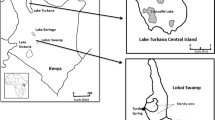Abstract
Temperature regime is known to have considerable influence on the life-histories of fish. Topmouth gudgeon is a very successful invader with high biological flexibility and phenotypic plasticity. The flexibility of topmouth gudgeon in a normal thermal regime has been well described, however there has been no information published about how it would cope with extreme conditions, e.g. permanently heated water. Several studies have demonstrated that phenotypic plasticity provides an important advantage to invasive species. To explain their invasion success, the theory of alternative ontogenies and invasive potential has been proposed. The aim of the present study was to examine if the reproductive parameters of a population living in permanently heated water differ from those living in habitats with a normal temperature regime, as well as to test a hypothesis derived from the theory of alternative ontogenies and invasive potential. Over a period of 8 years (2004–2011), a high variation in the reproductive parameters of topmouth gudgeon from Lake Licheńskie was found. With a small exception, all the observed results met the expectations predicted by the hypothesis tested. This indicates that topmouth gudgeon retains high phenotypic plasticity in life-history traits even in a habitat with extreme conditions, which is important for the species’ invasion success.
Similar content being viewed by others
References
Fox M.G., Growth, density and interspecific influences on pumpkinseed sunfish life histories, Ecology, 1994, 75, 1157–1171
Dhillon R.S., Fox M.G., Growth-independent effects of temperature on the life history traits of Japanese medaka (Oryziaslatipes), Copeia, 2004, 37–45
Kováč V., Developmental plasticity and successful fish invasions, In: Quint B. (Ed.), 17th International Conference on Aquatic Invasive Species (29 August–2 September 2010, San Diego, California, USA), 2010, 160
Kováč V., Genes and Development, In: Hutchins M. (Ed.), Grzimek’s Animal Life Encyclopedia, Evolution, Farmington Hills, Gale, 2011
Fox M.G., Vila-Gispert A., Copp G.H., Lifehistory traits of introduced Iberian pumpkinseed Lepomis gibbosus relative to native populations. Can differences explain colonization success? J. Fish Biol., 2007, 71, 56–59, DOI:10.1111/j.1095-8649.2007.01683.x
Záhorská E., Švolíková K., Kováč V., Do invasive populations of topmouth gudgeon (Pseudorasbora parva, Temminck and Schlegel) from disturbed and undisturbed habitats follow different life-histories?, Int. Rev. Hydrobiol., 2013, 98, 61–71, DOI:10.1002/iroh.201201446
Cucherousset J., Copp G.H., Fox M.G., Sterud E., van Kleef H.H., Verreycken H., et al., Life-history traits and potential invasiveness of introduced pumpkinseed Lepomis gibbosus populations in northwestern Europe, Biol. Invasions, 2009, 11, 2171–2180, DOI: 10.1007/s10530-009-9493-5
Záhorská E., Kováč V., Environmentally induced shift in reproductive traits of a long-term established population of topmouth gudgeon (Pseudorasbora parva), J. Appl. Ichthyol., 2013, 29, 218–220, DOI: 10.1111/jai.12039
Kováč V., Copp G.H., Sousa R.P., Life-history traits of invasive bighead goby Neogobius kessleri from the middle Danube with a reflection of who may win the goby competition, J. Appl. Ichthyol., 2009, 25, 33–37
Feiner Z.S., Aday D.D., Rice J.A., Phenotypic shifts in white perch life history strategy across stages of invasion, Biol. Invasions, 2012, 14, 2315–2329, DOI 10.1007/s10530-012-0231-z
Colautti R.I., MacIsaac H.J., A neutral terminology to define ‘invasive species’, Divers. Distrib., 2004, 10, 135–141
Záhorská E., Kováč V., Falka I., Beyer K., Katina S., Copp G.H., et al., Morphological variability of the Asiatic cyprinid, topmouth gudgeon Pseudorasbora parva, in its introduced European range, J. Fish Biol., 2009, 74, 167–185, DOI:10.1111/j.1095-8649.2008.02121.x
Záhorská E., Kováč V., Reproductive parameters of invasive topmouth gudgeon Pseudorasbora parva (Temminck and Schlegel, 1846) from Slovakia, J. Appl. Ichthyol., 2009, 25, 466–469, DOI: 10.1111/j.1439-0426.2009.01190.x
Záhorská E., Kováč V., Katina S., Age and growth in a newly-established invasive population of topmouth gudgeon, Cent. Eur. J. Biol., 2010, 5, 256–261, DOI: 10.2478/s11535-010-0002-8
Gozlan R.E., Andreou D., Asaeda T., Beyer K., Bouhadad R., Burnard D., et al., Pan-continental invasion of Pseudorasbora parva: towards a better understanding of freshwater fish invasion, Fish. Fish., 2010, 11, 315–340, DOI: 10.1111/j.1467-2979.2010.00361.x
Yan Y., Chen Y., Variations in reproductive strategies between one invasive population and two native populations of Pseudorasbora parva, Curr. Zool., 2009, 55, 56–60
Socha D., Zdanowski B., Aquatic ecosystems in the vicinity of Konin, Biblioteka Monitoringi Środoviska, Poznań, 2001, (in Polish)
Anonymous, Environmental Issue Report No1 “Analysis of the most important environmental problems. Disturbance of hydrologic system in Konin region.”, 2013, http://investor.kr-ustecky.cz/reregionsmezinarodni_konference_most/OE1IRPL.PDF
Holčík J., Hensel K., Handbook of Ichthyology, Obzor, Bratislava, 1972
Trippel E.A., Harvey H.H., Reproductive responses of five white sucker (Catostomus commersoni) populations in relation to lake acidity, Can. J. Fish. Aquat. Sci., 1987, 44, 1018–1023
DeMaster D.P., Calculation of the average age of sexual maturity in marine mammals, J. Fish. Res. Board. Can, 1978, 35, 912–915
Šumer S., Kováč V., Povž M., Slatner, M., External morphology of a Slovenian population of pumpkinseed Lepomis gibbosus (L.) from a habitat with extreme thermal conditions, J. Appl. Ichthyol., 2005, 21, 306–311
Balon E.K., Alternative ontogenies and evolution: a farewell to gradualism, In: Hall B.K., Pearson R.D., Muller G.B. (Eds.), Environment, development and evolution, toward a synthesis, MIT Press, Cambridge, 2004
Kapusta A., Bogacka-Kapusta E., Czarnecki B., The significance of stone moroko, Pseudorasbora parva (Temminck and Schlegel), in the smallsized fish assemblages in the littoral zone of the heated Lake Licheńskie, Arch. Pol. Fish., 2008, 16, 49–62
Author information
Authors and Affiliations
Corresponding author
About this article
Cite this article
Záhorská, E., Kováč, V., Švolíková, K. et al. Reproductive parameters of topmouth gudgeon (Pseudorasbora parva) from a heated Lake Licheńskie (Poland). cent.eur.j.biol. 9, 212–219 (2014). https://doi.org/10.2478/s11535-013-0252-3
Received:
Accepted:
Published:
Issue Date:
DOI: https://doi.org/10.2478/s11535-013-0252-3




